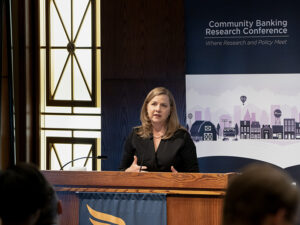
Interest rate cuts are unlikely in the near future due to lingering economic risks, said Federal Reserve Gov. Michelle Bowman on Feb. 12 during the American Bankers Association’s Conference of Community Bankers in San Antonio.
The Federal Open Market Committee maintained its target range for the federal funds rate at 5.25 to 5.50 percent last month while continuing to sell the Fed’s securities holdings. PCE inflation was below 3 percent for both total and core measurements for the first time since the spring of 2021, and fourth quarter real gross domestic product increased 3.3 percent.
Still, Bowman views the current target rate as appropriate. She sees multiple risks to the economy, including potential impacta of the ongoing war between Russia and Ukraine and Middle East conflict on energy and food markets. Following last month’s FOMC meeting, Fed Chair Jerome Powell said an interest rate reduction is unlikely next month. Investors are reportedly guessing that the first interest rate cut will come in May.
More economists are saying that the FOMC’s approach to combating inflation is too severe. According to a January survey from the National Association for Business Economics, 21 percent believed the Fed’s current fiscal policy was “too restrictive,” the third-highest reading in the last two decades.
Much of Bowman’s speech focused on her opposition to recently unveiled regulations. Bowman called more stringent bank capital rules unveiled in the past year “a major step backward” from a tailored regulatory framework.
Bowman said community bankers are devoting a greater portion of their resources to compliance and risk management tasks as policymakers continue to evaluate the root causes of last spring’s bank failures. She expressed concern that the worsening regulatory environment is driving more traditional bank activities to less-regulated nonbanks.
Those comments came one week after several trade associations, including the ABA, sued federal regulators for allegedly exceeding their statutory authority during recent updates to the Community Reinvestment Act. The lawsuit was filed against the Federal Reserve, FDIC and Office of the Comptroller of the Currency in the Northern District of Texas.
Trade groups involved in the lawsuit include the ABA, U.S. Chamber of Commerce, Independent Community Bankers of America, Texas Bankers Association, Independent Bankers Association of Texas, Amarillo Chamber of Commerce and Longview Chamber of Commerce. The groups are seeking a preliminary injunction against the CRA update along with a court order that the update is illegal.
There isn’t a clear regulatory definition of a community bank, Bowman said. Though the commonly-accepted current threshold is $10 billion, some regulations have imposed lower limits. Under the modernized CRA rule, a small bank is defined as having up to $600 million in assets, while an intermediate-sized bank has up to $2 billion.
Bowman also expressed concern over uncertainty in the bank merger application process. The OCC recently proposed ending the default approval of certain merger applications after a given time period; it also proposed adding transparency to standards consistent with merger approvals and denials. To Bowman, the plan harms M&A, which she sees as especially important for the longevity of community banking as smaller banks generally have fewer options to raise capital or grow their banking business than their larger peers.
Policymakers should consider enacting regulations tailored to the risk profile of a bank rather than standards based only on asset thresholds, Bowman said. She called on regulators to understand the risks of enacting overly burdensome regulations, especially for banks with minimal resources.
